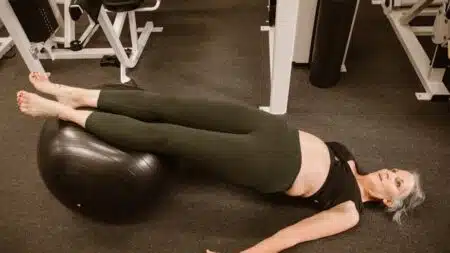A strong core powers every movement, stabilizing your torso, aiding balance, and transferring power from lower to upper body. However, many overlook the pelvic floor – an intricate web of muscles forming the innermost layer of your core that supports reproductive, urinary, and digestive wellness. Alarmingly, up to 25% of women face debilitating pelvic floor disorders caused by muscular weaknesses, leading to symptoms like incontinence, pelvic organ prolapse, and painful intercourse that disrupt daily life.
Fortunately, vaginal weights offer a discreet, effective solution for strengthening the pelvic floor from the inside out. These small weighted devices, called vaginal cones, are designed to be inserted vaginally, providing gentle resistance that directly engages and tones the often-neglected pelvic muscles for comprehensive core fitness.
Understanding Pelvic Floor Anatomy
Your pelvic floor forms a supple hammock attached to your tailbone, hip bones, and pubic bone. Ligaments interlink with layers of muscle that contract and relax to influence bladder and bowel control. Additional tissues contribute to sexual function and pleasure while securing organs like the uterus, bladder, and rectum in optimal alignment. Yet despite its far-reaching impact, minimal sensation comes from the cervix or surrounding pelvic zone. Out of sight and out of mind, these crucial structures rarely enter mainstream dialogue or fitness plans. However, overlooking pelvic floor self-care leaves you prone to painful, disruptive symptoms.
Who Benefits from Targeted Pelvic Floor Training?
Strengthening your pelvic floor grows increasingly beneficial during milestones like pregnancy, postpartum recovery, and menopause. Surging hormones and physical changes strain supporting tissues, raising risk for pelvic floor disorders. Incorporating vaginal weights counteracts muscular fatigue and deterioration, upholding fluid circulation and nerve conduction.
Patients already struggling with pelvic pain, urinary dysfunction, or prolapse also respond well to gentle, progressive training protocols. Whether treating diagnosed conditions or striving for optimal wellness, vaginal weights boost stamina and control from your body’s foundation. Strengthened pelvic floor tissues better withstand daily and sporadic demands like coughing, laughing, heavy lifting, or high-intensity workouts.
Understanding How Vaginal Weights Work
Vaginal weights promote pelvic floor gains through internal resistance, capitalizing on body positioning and gravity. Weights range from 0.5 to 5 pound ovular or cone-shaped devices with a retrieval cord or handle. The unit’s weighted bulb or end is inserted into the vaginal canal, prompting lift and clench motions against gravity’s downward pull. This engages muscle fibers similar to natural contractions during labor, sex, or a kegel squeeze.
Maintaining proper alignment while using vaginal weights transforms typically passive pelvic structures into dynamic, engaged tissues. Constant muscular work counteracts atrophy and weakness which can progress to prolapse or leakage. Patients feel subtle burns, shakes, squeezes, pulses, flutters, and holds targeting varied motor units. Varying weights, positions, contraction times, and rest periods stresses these muscles for heightened adaptations over time.
Advancing Your Vaginal Weight Routine
As with any fitness endeavor, progressing gradually with vaginal weights optimizes gains. Beginners start with lighter options for short 5-10 minute sessions every other day. Monitoring acute soreness guides reasonable weight increases each month. Consistency sparks slow but measurable improvements as tissues strengthen, stabilize, then grow. Integrating vaginal training just 2-3 days per week elicits benefits.
To bolster your routine, experiment with different postural progressions, activity pairings, contraction times, and rest intervals:
- Posture – Move through quadruped, supine, seated, and standing flows.
- Pairings – Coordinate with Pilates, yoga, dance, or barre.
- Duration – Build from quick flutters toward 10, 20 or 30 second holds.
- Rest – Allow muscles full reset between sets.
Enhance mind-body awareness through focused pelvic floor interludes. With relaxed breathing, isolate subtle lifts and pulses that gradually intensify in depth and hold times. Phase muscle fatigue warrants concluding each sessionbefore reaching total failure to preventoverexertion. Review new exercises or weight increments with your specialist to ensure proper sequencing.
Combining Internal and External Exercises
While vaginal weights target internally, blending external movements expands total core activation. Alternate focused pelvic sets with full-body flows training muscles in isolation then unified function. Here are complementary exercises worth integrating:
- Kegels – Classic pubococcygeus isolation exercise.
- Bridge Pose – Engages glutes, hamstrings, lower back, and pelvic floor.
- Dead Bug – Challenges transverse abdominals and pelvic stability.
- Squats – Strengthen legs while incorporating pelvic floor engagement.
- Hip Thrusters – Works legs, glutes, core, and pelvic floor synergistically.
This layered approach prepares the pelvic floor for diverse real-world demands, reducing injury risks. Consistently counteracting muscular imbalances and connective tissue laxity bolsters overall posture, stability, and continence. Gradually mastering more complex skills with improved awareness, efficiency, and strength epitomizes successful rehabilitation.
The Road to Pelvic Floor Wellness
Committing to daily pelvic floor self-care reaps lifelong rewards by upholding bodily independence and self-confidence. Though rarely discussed compared to trending workouts, fundamentally training these intricate muscles benefits people across gender and age spectrums. Children develop better posture and continence through early pelvic floor education while seniors maintain stability by prioritizing balance and fall prevention.
During pivotal windows like pregnancy, postpartum, or menopause, proactively strengthening the pelvic floor minimizes avoidable harm. But rather than reacting to problems as they arise, create daily groundwork enabling graceful adaptation to life’s ebb and flow. Using vaginal weights builds physical durability alongside emotional resilience to withstand uncertainties ahead. Treat pelvic floor fitness as routine wellness maintenance through all seasons of womanhood.
While advancing through complex routines, maintain proper posture and breathing rhythms. Draw low abdominals gently inward as if bracing the spine without fully holding breath. Inhale briskly through the nose before pursing lips to exhale smoothly. Time contractions and partial releases with measured breath cycles that mirror gentle ocean waves. Quiet moments focused solely on pelvic awareness cultivate mind-body harmony.
With advanced weights and personalized programming, something as simple as an internal lift becomes training for the long haul. So whether overcoming specific diagnoses or striving for your athletic best, give your pelvic floor license to shine. Because remarkably, empowering oft-ignored tissues signifies so much more – full embodiment on your unique terms.
Troubleshooting Plateaus with Vaginal Weights
Plateaus inevitably occur even with excellent compliance and programming. If vaginal weights seem less effective lately, evaluate these common training hang-ups before changing your routine:
- Inadequate Recovery Allow at least one full day of rest between strength sessions. Muscles broken down through training require 48-72 hours rebuilding stronger than before. Scheduling appropriate rest, fuel, sleep, and stress management accelerates gains.
- Poor Breathing Technique Rushed inhales and clenched exhales during exertion deprive muscles of oxygen while building excess tension. Refresh proper breathing fundamentals with your specialist. Time flows with measured breaths promoting muscular endurance.
- Insufficient Nutrition
Protein and carb intake dictates just how much muscle you build from training. Lacking key amino acids for tissue repair or glycogen for energy reserves hinders progress. Assess nutrition gaps with an expert. - Overtraining Pushing one area too often causes repetitive strain and stagnation. Vary core exercises across planes of motion to keep adapting. Muscles strengthen most dramatically in response to new challenges.
- Under-Progressing Weights Using the same low-level weights weeks on end wastes potential. Gradually progress weights every 4-6 weeks to continually trigger growth. Increase time under tension if adding weight seems unfeasible.
- Poor Mind-Muscle Connection Simply repeating motions ignores much benefit locked within each rep. Check for overreliance on momentum. Consciously engage target areas with focused intention during each squeeze and pulse.
Adjust training obstacles as able, then watch your body respond. Plateaus pass when you align intelligent effort with patience. Trust in progress gained so far, and keep perspective through temporary standstills. Consistency compounds over time.
The Takeaway: Why Vaginal Weights Matter
In an ever-busy, chaotic world, people commonly disconnect from foundational needs until crisis strikes. Yet the vaginal weight path progresses beyond reactionary fixes to proactive self-care. Training core muscles lining internal organs trains total embodiment from the inside out. Though humbling at first, respecting your body’s wisdom manifests outward confidence and success.
While advancing through complex regimens, maintain mindfulness. Quiet moments focused solely on timed inhales and pelvic floor pulses cultivate deeper mind-body awareness. Gradually mastering more intricate movements requires tuning into subtle physical cues. Allow each contraction and release to emerge from inner authority, on your terms. Absolute control over personal health and happiness no longer seems an impossible ideal once you genuinely listen.
So get acquainted with your pelvic region, and unlock strengths waiting within. Because remarkably, empowering oft-ignored tissues signifies so much more – full expression on your unique terms. No matter what brought you to vaginal weights, commit to small steps compounding over time. Consistency builds the foundation supporting whoever you strive to become.



